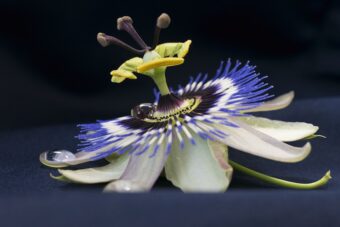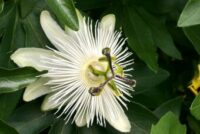In this article, we will be discussing how to grow passionflowers in containers. Passionflower or Passiflora to give its Latin name is a species that mainly originated from tropical woodlands in Central and South America. It is also found in Asia, Australia and the Pacific.

As you can imagine from the location shown, it is not a hardy plant and only a few varieties can be grown outdoors in the UK. In fact, a lot of the more exotic varieties need a temperature greater than 10 degree Celsius and so are only suitable for greenhouses.
The flowers are so wonderful, showy and often fragrant. They are typically broad, flat, circle of painted petals with a raised, fringe corolla in the centre. The flowers of the showy reproductive parts, later on, produce oval fruits, where some of these fruits are edible. The colour of the flowers varies widely, where they cling on to trellises, pergolas, and arbours via the tendrils they produce.
The name of the passionflower comes about when Spanish priests in South America saw the resemblance of the flower with Christ’s passion. The three stigmas present the 3 nails used; the fiver anthers represent the 5 wounds that Christ exhibited; and the ten tepals representing the apostles without Peter or Judas being present. The typical purple-blue and white the flower shows represent heaven and purity.
In a warm climate, the vines grow vigorously, especially in gardens where their beauty can be observed.
The hardier varieties tend to grow in a sunny and sheltered spot. The tender types must be protected from winter frosts by either protecting them by covering with fleece or bubble wrap or they must be grown all year round in a heated greenhouse or conservatory.
HOW TO PLANT PASSIONFLOWER
Generally, when you buy passionflower varieties you but them as 9cm pots, where they can be planted out when the soil is not frozen or frosts are no longer being forecasted.
The common, hardy variety Passiflora caerulea can be bought online or from garden centres, When selecting a plant make sure that you buy a hardy variety for directly planting outdoor, Use any tender varieties for indoor or greenhouses. In general, blue and white varieties are the hardiest and red are the tenderest.
To support a passionflower you need to use strong support such as a wall, fence with a trellis or where wires run on top of these. The growing stems must be loosely tied before the plant tendrils will start to grip by themselves.
USE A POT THAT IS AT LEAST TWICE AS BIG AS THE ROOTBALL
To plant a new passion flower plant in a container, you need to use a pot that is least 2 times the size of the pot it came in the nursery. Place the container at least 15cm away from the walls, fences, trellises, arbours or pergolas that are supporting the vines.
Fill the plant pot, ensuring that it has drainage holes, with a well-drained but moisture-retentive, multipurpose compost, to a level of a third from the bottom.

Place the plant in the new container and then backfill it to cover the whole plant at the same level, so the root ball is not planted any deeper. Place two short canes in the hole at the same time, so that the top of the cane touches the wall, fence or trellis to allow the vine to reach the support. Ensure that the top of the compost is 12cm below the top of the container.
DO NOT FORGET TO TIE THE PLANT IN
Once the plant is situated well in the container, you need to tie the stems onto the canes and then secure the plant very well.
The plant prefers to be grown in full sun, but in a sheltered location from drying, cold winds. Plants in greenhouses or conservatories may need shading from direct, afternoon sunlight to avoid sunscald of the leaves.
When you water do it very well in the first year to help the plant to establish. With plants in pots, this is more important, especially in summer where the hot temperatures can cause the plant to wilt. In winter, you only need to water sparingly to avoid potential root rot problems.
Plants in containers need to be fed regularly at least every 2 weeks with a liquid fertilizer, such as Phostrogen during the growing season.
It is believed that having the plant slightly root bound will help the passionflower to flower profusely, so do not be in a rush to pot on. You will probably need to do this eventual, at least once every 3 to 4 years and the roots will need to be examined quite frequently.
HOW TO PRUNE PASSIONFLOWER
A passionflower needs to be pruned to keep the plant to its desired form and shape, to make the plant bushier and to rejuvenate a neglected plant.
After planting a new vine, cut back the growing tips of the shoots to promote branching at the base. The new shoots from the base that will be used to form the framework to encourage a typical fan shape.

Enough space needs to be made between the fan elements to display the hanging flowers of some type of passionflower.
Once the fan shape has been established it needs to be pruned in spring to remove excessive shoots (any side-shoots cutback to a couple of buds from the main framework) or shoots that are frost damaged. This will maintain its shape.
Overgrown passion vines can be renovated pruned in spring, where each stem is cut back to a bud 5cm above soil level. New green shoots will soon follow and they can be shaped to your own preference. It will cut flowering back for a couple of years but in the long run, it will be better for the plant.
One advantage is that passionflowers are not attacked by pests apart from aphids for outdoor plants and red spider mites, whitefly, scale and mealybugs for greenhouse or indoor plants. They can get viruses and bacterial leaf spots, which can be detrimental to the plant. If these diseases are present the plant will need to be destroyed and replaced with new stock.
VARIETIES TO GROW
Passiflora caerulea is the most common, blue-purple passionflower that is found in the UK. It is hardy, especially if they are grown on a sheltered and warm spot, where it will retain its green leaves over winter.

The spring and summer flowers that are large are mainly white but have pink tinge and purple-blue filaments that arise from the centre. The flowers are followed by yellow egg-shaped fruits that appear in late summer. Varieties to look for includes ‘Eden’, ‘Grandiflora’ and ‘Constance Elliot’
Passiflora ‘White Lightning’ is a white variety of passionflower, with green stamens and purple filaments.
Passionflora ‘Amethyst’
Passiflora ‘Amethyst’ has rich violet flowers with contrasting green filaments. The petals darken as the flower ages. Other purple type passionflowers include ‘Purple Rain’ and Passiflora x violacea.
Passionflora mollissima
Passiflora mollissima (Banana Passion Flower) has long, golden –yellow fruits that emerge from hanging, pale pink tubular flowers. It is not a hardy plant but is best grown inside a greenhouse, where it will romp away quite happily.
Passionflora antioquensis
A red counterpart, known as Passiflora antioquiensis (Red Banana Passionflower) that has long, pendulous stems and 15cm wide, red flowers. Can be grown in a heated conservatory, as it is too tender to grow outside.
Passionflora alata

Passiflora Alata (Wing-stem Passionflower or Fragrant Granadilla) produces deep red, scented flowers with red, purple and white decorations that appear from June to October. It is borderline hardy, where in mid-May it can be planted in a sheltered spot in warmer parts of the UK, but it will need careful protection from the cold. In the north of the UK, it will need to be grown in a conservatory.
Passionflora quanrangularis
Varieties to grow under a conservatory is Passiflora quadrangularis(the Giant Granadilla) that produces fragrant, deep red flowers with a centre of reddish-purple, white and pink banded wavy filaments. This vigorous clumber need a lot of heat, so it can survive all year round, as it cannot take temperatures below 15 degrees Celsius.
Passionflora manicata
Passiflora manicata (Red Passion Flower). This is a plant the produces red, small, blue-white centred flowers that tend to be 5cm long and produces green, oval fruits. It does not like temperatures below 7 degree Celsius, so it will not survive outside in winter, where it needs to be brought into a conservatory or grown in a greenhouse all year round.
Passionflora racemosa
Another red glower variety is Passiflora racemosa that has clusters of showy, scarlet flowers that grow up to 30cm in length and 12cm in diameter when fully open. Another variety that needs to be grown in a greenhouse to do well, where the fruits are green and large.
CONCLUSIONS
In this article, we have discussed how to grow passionflower in containers. As you can see there is plenty of specimens that can be grown outside in the garden and colourful varieties that need to be grown in a warm conservatory or greenhouse to do well.
Passionflowers are not difficult plants to grow as long as you feed right, water right and grow the right variety. They will give you many years of pleasure.
They not only look good but provide not only colour but some of the fruits are edible, an added bonus.
If you have any comments or questions that you wish to make, please do so in the comment box below.
Put the Passion into your container garden.

The passion flower does seem to be a very beautiful flower. Well, I have never seen it physically. This is in fact the first time I will be hearing of the passion flower and also seeing a picture of the passion flower. I have indeed learnt a lot about the passion flower from reading this article and I feel excited about it. Thanks for this beautiful article.
Hi Kelvin
Thank you very much for stopping by and commenting. Indeed passionflowers are very colourful and they do bring great colour and height to the container garden. I hope you think about buying a specimen or two,
Thanks
Antonio
Hi Antonio,
That is a beautiful post. I didn’t know there are so many different passifloras. I myself tried to put 2 plants into my garden, but they didn’t grow very well, and 2 years later they died. Maybe the place was not sunny enough. I live in the Netherlands, and our winters are not that cold anymore, so they should have survived the winter. I have no idea why they didn’t come. Your post created the desire in me to try it again with a passiflora. Do you protect them with a blanket or something else in winter?
Hi Sylvia
I am really glad that you enjoyed the article. It is a surprise that there are a lot of passionflower varieties, it is a shame that some are not hardy. The common passionflower is the hardest and should survive cold winter, cover with fleece or mulch should protect them further but we are subjected to the elements. I hope you do try again as you will have such beautiful climbers in your garden.
Thanks
Antonio